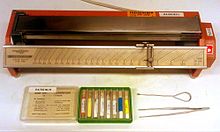Ludwig Kofler (pharmacologist)
Ludwig Kofler (also Louis Kofler , born November 30, 1891 in Dornbirn , † August 23, 1951 in Innsbruck ) was an Austrian pharmacologist .
Life
Kofler was a professor at the Pharmacognostic Institute of the University of Innsbruck and from 1925 to 1945 its director. He was the son of the pharmacist Karl Kofler. He studied at the University of Vienna , where he became a doctor of philosophy (major Botany) PhD was and received a master's degree from the pharmacy. After serving in the war, he returned to Vienna and also received his doctorate in medicine. Then he took over the newly created chair for pharmacognosy in Innsbruck.
Kofler joined the NSDAP in 1934 . After the annexation of Austria , he was appointed Gaudozentenbundführer of Tyrol-Vorarlberg and the Lecturer League Leader of the University of Innsbruck in 1938/39 . In 1938 he also joined the SS and in 1939 was appointed SS-Untersturmführer. After the Second World War , Kofler was released in 1945. In 1949, the layoff was converted into a retirement. In 1951 he committed suicide.
Kofler hot stage microscope
A micro-melting point apparatus was described by Kofler in 1931, later provided by him with a simplified temperature measurement and called a hot stage microscope. It is a further development of the crystallization microscope introduced by Otto Lehmann and has an electrically heated metal plate in the object level (typical temperature range 50 ... 350 ° C). There is an opening in the middle of the plate to allow the light from the microscope to pass through. This heating cuvette is protected from the ambient air with a metal ring and a glass cover plate. The temperature is read with a thermometer or thermocouple .
The hot stage microscope is suitable for determining the melting point of small amounts of substances. According to Kofler, the microscope can also be used to observe the sublimation of organic substances and to determine the refractive index curve of a melt over temperature. For the latter purpose, glass fragments of known refractive index are added to the melt and it is observed at which temperature they become invisible - at this temperature the refractive index of the melt and the glass are the same. Another application is the investigation of the solid-solid phase transition of polymorphic substances. Depending on the temperature, changes in the external crystal shape ( crystal habit ), color or birefringence in polarized light can be observed under the microscope . If two substances are heated next to each other on the heating table, the behavior of the binary system can be studied in the contact area ( contact method ).
Kofler heating bank
The heating bench for the rapid determination of the melting point was described by Kofler in an article submitted in 1949. It consists of an elongated, polished metal plate on which a temperature gradient is applied. According to Kofler, this is achieved with several aluminum or copper strips of different lengths underneath, which, due to their good thermal conductivity, lead the heat from one side to the other. For calibration , lines of pure substances are applied, the melting point of which is precisely known. A temperature scale of the metal plate can then be created from the observed melting points of these substances. Once this scale has been determined, the heating bench can be used to investigate the behavior (melting point, sublimation, polymorphism, etc.) of new powdery substances by spreading them over the metal strip from the cold side and determining the location of the melting point.
Awards
- 1934: Fritz Pregl Prize
Publications
- with Adolf Mayrhofer : medicine cabinet and prescription. J. Springer, Vienna 1929.
- with Adelheid Kofler , Adolf Mayrhofer: Microscopic Methods in Microchemistry , Verlag Emil Haim, Vienna Leipzig 1935.
- with Adelheid Kofler: Micro-methods for labeling organic substances and mixtures of substances. Verlag Chemie, Berlin 1945.
- with Adelheid Kofler, Maria Kuhnert-Brandstätter Thermo-micro-methods for labeling organic substances and substance mixtures. 3rd probably edition, Verlag Chemie, 1954.
literature
- Maria Brandstätter: Microchimica Acta (1951) 38, 295-308.
- Gerhard Oberkofler : Ludwig Kofler . In: Vorarlberger Verlagsanstalt (ed.): Montfort. Quarterly magazine for the past and present of Vorarlberg . 24th year, issue 3-4, 1972, p. 593-603 .
- Erika Hickel : Kofler, Ludwig. In: New German Biography (NDB). Volume 12, Duncker & Humblot, Berlin 1980, ISBN 3-428-00193-1 , p. 420 ( digitized version ).
- DC Lee, M. Webb: Pharmaceutical Analysis , Blackwell Publishing (2003), pp. 275-276.
- Michael Grüttner : Biographical Lexicon on National Socialist Science Policy (= Studies on Science and University History. Volume 6). Synchron, Heidelberg 2004, ISBN 3-935025-68-8 , p. 96.
Web links
- Literature by and about Ludwig Kofler in the catalog of the German National Library
- Development of pharmacognosy at the Leopold-Franzens-University in Innsbruck ( Memento from October 18, 2012 in the Internet Archive )
- Louis (Ludwig) Kofler , entry in lexikon.dornbirn.at
Individual evidence
- ↑ Michael Grüttner : Biographical Lexicon for National Socialist Science Policy (= Studies on Science and University History. Volume 6). Synchron, Heidelberg 2004, ISBN 3-935025-68-8 , p. 96.
- ^ A b Ludwig Kofler: About the hot stage microscope and its additional devices. In: microscopy. Vol. ??, page 164ff, PDF on ZOBODAT
- ↑ Kofler, L .; Kofler, A .: About a heating bench for the rapid determination of the melting point in W. Mikrochim Acta (1949) vol. 34, p. 374.
- ^ Walter Wittenberger: Chemische Laboratoriumstechnik , Springer-Verlag, Vienna, New York, 7th edition, 1973, pp. 221–222, ISBN 3-211-81116-8 .
| personal data | |
|---|---|
| SURNAME | Kofler, Ludwig |
| BRIEF DESCRIPTION | Austrian pharmacologist and inventor |
| DATE OF BIRTH | November 30, 1891 |
| PLACE OF BIRTH | Dornbirn |
| DATE OF DEATH | 23rd August 1951 |
| Place of death | innsbruck |
